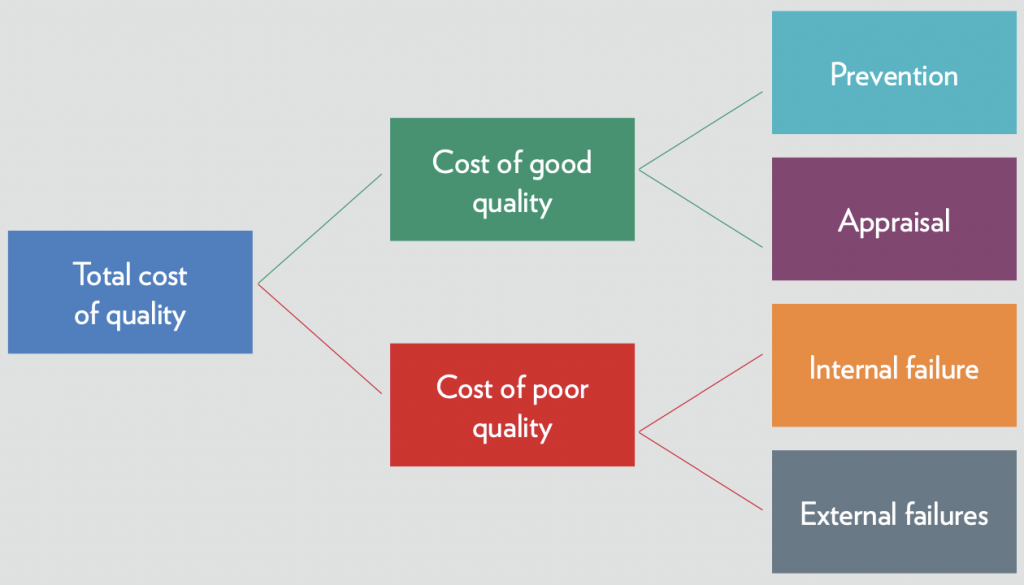When one studies the literature around the Cost of Quality, the traditional breakdown of the costs is presented as follows:

Source: ASQ TR2:2018.
ISO 10014 and ASQ TR 2, two standards that provide guidelines (in other words, advice, rather than a set of requirements like ISO 9001), follow this logic.
The problem is, it leaves a lot of extra costs unaccounted for.
What makes up the cost of poor quality, in the traditional view?
If something cannot be counted, it cannot be tracked and managed, or so goes the general philosophy. That’s why the focus is on expenses that can be tracked and cannot easily be disputed.
The two usual buckets are:
- Internal failures — consequences of poor quality when it is detected before shipment. Examples: a batch is put aside and sorted (with requires 100% inspection), some parts are scrapped (which is a lot of material + all the processing already done), some parts are reworked and re-tested.
- External failures — consequences of poor quality when it is detected after shipment, by a customer or their own customers/users. Examples: complaint and chargebacks from a customer; request to pay for transportation to and from a rework facility; request to pay for all the rework costs and to re-produce those products that cannot be reworked; request for full reimbursement + penalty; request to go in the field and replace defective products.
One could keep going with a long list when it comes to the extra costs triggered by such failures.
Here are some common expenses a manufacturer has to suffer because of internal and/or external failures:
- A delay because of the extra operations, and an emergency change in production plans (reducing production efficiency);
- A penalty for late shipment;
- An expedited shipment, for example by air rather than sea;
- Lower reliability of the end products because some of them have been reworked somewhere along the process — that can often show up in extra warranty costs.
What is missing in the costs of poor quality as they are usually measured?
Not everything that counts can be counted, and not everything that can be counted counts, as William Bruce Cameron wrote in the 1960s.
In Metrics in Lean – Part 2 – Quality, Michel Baudin makes the same point:
Cost of Quality (COQ) metrics, for example, are limited to the direct costs of failure, appraisal and repair, which do not even begin to account for the sales impact of the company’s reputation for quality.
In the long run, what is the real cost of losing some customers, being awarded a lower amount of business from customers, and having a poor reputation that turns away potential customers? How much profit is destroyed that way? Probably much more than the direct cost of dealing with repeated failures.
That’s why many people believe the costs of poor quality, because they are only based on verifiable data that are translated into financial numbers, are always under-estimated.
And it has a very detrimental effect.
That’s why most companies’ quality systems focus more on detecting failures (confirming a standard, doing inspections, writing corrective action plans…) and little on preventing failures (picking better suppliers, hiring & training the staff in a better way, keeping equipment in good condition, making the work easy and making mistakes non-intuitive…).
So, can one justify focusing a lot of resources on quality improvement as a way to cut total costs?
In many cases, yes. When the cost of failures is very high, it is sufficient to demonstrate that quality improvement will lead to a lower overall cost.
And that’s only when a company tracks the cost of poor quality. I noticed that many don’t do a good job at that. Many don’t even aggregate the different customer complaints.
In other cases, a purely financial approach will not be sufficient.
It usually takes leadership (as opposed to ‘good-old-management-by-numbers’) to recognize that better quality will lead to lower total costs and/or higher revenue.
********
What have you observed about the cost of poor quality that you can share with us? Have many companies managed to kick-start a quality improvement initiative just by counting the costs of failures? What approach worked best?

